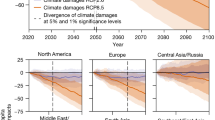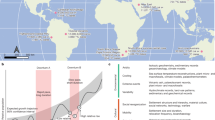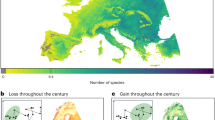Abstract
Studies of modern famines tend to consider them ‘man-made’, resulting from war or from adverse shocks to food entitlements. This view has increasingly been applied to historical famines, against the earlier Malthusian orthodoxy. We use a novel dataset and temporal scan analysis to identify periods when famines were particularly frequent in Europe, from ca. 1250 to the present. Up to 1710, the main clusters of famines occurred in periods of historically high population density. This relationship disappears after 1710. We analyse in detail the famines in England, France and Italy during 1300–1850, and find strong evidence that before 1710 high population pressure on resources was by far the most frequent remote cause of famines (while the proximate cause was almost invariably meteorological). We conclude, in contrast with the currently prevailing view, that most preindustrial famines were the result of production, not distribution issues. Only after 1710 did man-made famines become prevalent.
This is a preview of subscription content, access via your institution
Access options
Access Nature and 54 other Nature Portfolio journals
Get Nature+, our best-value online-access subscription
$29.99 / 30 days
cancel any time
Subscribe to this journal
Receive 12 digital issues and online access to articles
$119.00 per year
only $9.92 per issue
Buy this article
- Purchase on Springer Link
- Instant access to full article PDF
Prices may be subject to local taxes which are calculated during checkout


Similar content being viewed by others
References
Ó Gráda, C. Famine. A Short History (Princeton Univ. Press, Princeton, NJ, 2009).
Fogel, R. W. The Escape from Hunger and Premature Death, 1700–2100: Europe, America, and the Third World (Cambridge Univ. Press, Cambridge, 2004).
The State of Food Security and Nutrition in the World 2017: Building Resilience for Peace and Food Security (Food and Agriculture Organization of the United Nations, 2017).
Sen, A. Poverty and Famine: An Essay on Entitlement and Deprivation (Clarendon Press, Oxford, 1981).
Fogel, R. W. in Nutrition and Poverty (ed. Osmani, S. R.) 243–286 (Clarendon Press, Oxford, 1992).
de Waal, A. Mass Starvation: The History and Future of Famine (Polity Press, Cambridge, 2018).
Ehrlich, P. R. & Ehrlich, A. H. The population bomb revisited. Electron. J. Sustain. Dev. 1, 63–71 (2009).
Rieff, D. The Reproach of Hunger: Food, Justice, and Money in the Twenty-First Century (Simon & Schuster, New York, NY, 2015).
Alfani, G. Calamities and the Economy in Renaissance Italy: The Grand Tour of the Horsemen of the Apocalypse (Palgrave, Basingstoke, 2013).
Alfani, G, & Ó Gráda, C. Famine in European History (Cambridge Univ. Press, Cambridge, 2017).
Tilly, L. A. Food entitlement, famine, and conflict. J. Interdiscip. Hist. 14, 333–349 (1983).
Zhang, D. D. et al. The causality analysis of climate change and large-scale human crisis. Proc. Natl Acad. Sci. USA 108, 17296–17301 (2011).
Lima, M. Climate change and the population collapse during the “Great Famine” in pre-industrial Europe. Ecol. Evol. 4, 284–291 (2014).
Turchin, P. & Nefedov, S. A. Secular Cycles (Princeton Univ. Press, Princeton, NJ, 2009).
Healey, G. The First Century of Welfare: Poverty and Poor Relief in Lancashire, 1620–1730 (Boydell, Woodbridge, 2014).
Smith, R. M. in Popular Culture and Political Agency in Early Modern Britain and Ireland (eds Braddick, M. J. & Withington, P.) 35–54 (Boydell, Woodbridge, 2017).
How to feed a hungry world. Nature 466, 531–532 (2010).
Malthus, T. R. An Essay on the Principle of Population, as it Affects the Future Improvement of Society (Johnson, London, 1798).
Coogan, T. P. The Famine Plot: England’s Role in Ireland’s Greatest Tragedy (Palgrave Macmillan, Basingstoke, 2012).
Curran, D., Luciuk, L. & Newby, A. G. (eds) Famines in European Economic History: The Last Great European Famines Reconsidered (Routledge, London, 2015).
Conquest, R. The Harvest of Sorrow: Soviet Collectivization and the Terror Famine (Hutchinson, London, 1986).
Mokyr, J. Why Ireland Starved: A Quantitative and Analytical History of the Irish Economy 1800–1850 2nd edn (Allen & Unwin, London, 1985).
Wheatcroft, S. in Famine in European History (eds Alfani, G. & Ó Gráda, C.) 212–239 (Cambridge Univ. Press, Cambridge, 2017).
Jordan, W. C. The Great Famine: Northern Europe in the Early Fourteenth Century (Princeton Univ. Press, Princeton, NJ, 1996).
Curtis, D., Dijkman, J., Lambrecht, T. & Vanhaute, E. in Famine in European History (eds Alfani, G. & Ó Gráda, C.) 119–140 (Cambridge Univ. Press, Cambridge, 2016).
Slavin, P. Warfare and ecological destruction in early fourteenth-century British Isles. Environ. Hist. 19, 528–550 (2014).
Hoyle, R. W. in Famine in European History (eds Alfani, G. & Ó Gráda, C.) 141–165 (Cambridge University Press, Cambridge, 2017).
Lachiver, M. Les années de misère. La famine au temps du Grand Roi, 1680–1720 (Fayard, Paris, 1991).
Béaur, G. & Chevet, J. M. in Famine in European History (eds Alfani, G. & Ó Gráda, C.) 73–100 (Cambridge Univ. Press, Cambridge, 2017).
Alfani, G., Strangio, D. & Mocarelli, L. in Famine in European History (eds Alfani, G. & Ó Gráda, C.) 25–47 (Cambridge Univ. Press, Cambridge, 2017).
Dribe, M., Olsson, M. & Svensson, P. in Famine in European History (eds Alfani, G. & Ó Gráda, C.) 185–211 (Cambridge Univ. Press, Cambridge, 2017).
Lamb, H. H. Climate, History and the Modern World (Routledge, London, 1982).
Luterbacher, J. & Pfister, C. The year without a summer. Nat. Geosci. 8, 246–248 (2015).
Post, J. D. Food Shortage, Climatic Variability, and Epidemic Disease in Preindustrial Europe: The Mortality Peak in the Early 1740s (Cornell Univ. Press, Ithaca, NY, 1985).
Dickson, D. Arctic Ireland: The Extraordinary Story of the Great Frost and Forgotten Famine of 1740–41 (White Row Press, Belfast, 1997).
Parker, G. Global Crisis: War, Climate Change and Catastrophe in the Seventeenth Century (Yale Univ. Press, New Haven, CT, 2013).
Campbell, B. M. S. The Great Transition: Climate, Disease and Society in the Late-Medieval World (Cambridge Univ. Press, Cambridge, 2016).
Bradley, R. S. & Jones, P. D. (eds) Climate since A.D. 1500 (Routledge, London, 1992).
Livi Bacci, M. A Concise History of World Population (Blackwell, Oxford, 2007).
Alfani, G. in From Malthus’s Stagnation to Sustained Growth (eds Malanima, P. & Chiarini, B.) 18–51 (Palgrave, London, 2013).
PAGES 2k Network Continental-scale temperature variability during the past two millennia. Nat. Geosci. 6, 339–346 (2013).
Mann, M. E. et al. Global signatures and dynamical origins of the Little Ice Age and Medieval Climate Anomaly. Science 326, 1256–1259 (2009).
Collet, D. & Schuh, M. Famines During the ‘Little Ice Age’ (1300–1800): Socionatural Entanglements in Premodern Societies (Springer, Cham, 2017).
Kelly, M. & Ó Gráda, C. Change points and temporal dependence in reconstructions of annual temperature: did Europe experience a Little Ice Age? Ann. Appl. Stat. 8, 1372–1394 (2014).
Hoyle, R. W. in The Farmer in England, 1650–1980 (ed. Hoyle, R. W.) 69–100 (Ashgate, Farnham, 2013).
Cook, E. R. et al. Old World megadroughts and pluvials during the Common Era. Sci. Adv. 1, e1500561 (2015).
Weir, D. R. Life under pressure: France and England, 1670–1870. J. Econ. Hist. 44, 27–47 (1984).
Broadberry, S., Campbell, B., Klein, A., Overton, M. & Van Leeuwen, B. British Economic Growth 1270–1870 (Cambridge Univ. Press, Cambridge, 2015).
Parker, G. The Military Revolution: Military Innovation and the Rise of the West 1500–1800 (Cambridge Univ. Press, Cambridge, 1988).
Carefoot, G. L. & Sprott, E. R. Famine on the Wind: Plant Diseases and Human History (Angus and Robertson, London, 1969).
Bourke, A. & Lamb, H. The Spread of Potato Blight in Europe 1845–6 and the Accompanying Wind and Weather Patterns (Meteorological Service, Dublin, 1993).
Campbell, B. Nature as historical protagonist: environment and society in pre-industrial England. Econ. Hist. Rev. 63, 281–314 (2010).
Alfani, G. & Murphy, T. Plague and lethal epidemics in the pre-industrial world. J. Econ. Hist. 77, 314–343 (2017).
Alfani, G. Plague in seventeenth century Europe and the decline of Italy: an epidemiological hypothesis. Eur. Rev. Econ. Hist. 17, 408–430 (2013).
Smith, A. An Inquiry into the Nature and Causes of the Wealth of Nations (eds Campbell, R. H. & Skinner, A. S.) (Oxford Univ. Press, Oxford, 1976).
Burke, M., Hsiang, S. & Miguel, E. Global non-linear effect of temperature on economic output. Nature 527, 235–239 (2015).
Lutz, W. How population growth relates to climate change. Proc. Natl Acad. Sci. USA 114, 12103–12105 (2017).
Del Panta, L. & Livi Bacci, M. Chronologie, intensité et diffusion des crises de mortalité en Italie: 1600–1850. Population 32, 401–446 (1977).
Ó Gráda, C. Eating People is Wrong and Other Essays on the History and Future of Famine (Princeton Univ. Press, Princeton, NJ, 2015).
Kelly, M. & Ó Gráda, C. Living standards and mortality since the Middle Ages. Econ. Hist. Rev. 67, 358–381 (2014).
Maxwell, D, & Majid, N. Famine in Somalia (Hurst, London, 2016).
Dupâquier, J. (ed.) Histoire de la population française (PUF, Paris, 1988).
Del Panta, L., Livi Bacci, M., Pinto, G. & Sonnino, E. La popolazione italiana dal Medioevo ad oggi (Laterza, Bari, 1996).
Alfani, G. in La popolazione italiana del Quattrocento e del Cinquecento (eds Carbone, A., Del Bo, B. & Rao, R.) 19–40 (Forum, Udine, 2016).
Wrigley, E. A. & Schofield, R. S. The Population History of England, 1541–1871: A Reconstruction (Cambridge Univ. Press, Cambridge, 1981).
Hinde, A. England’s Population (Arnold, London, 2007).
Clio Infra (Clio Infra, accessed 30 April 2018); https://www.clio-infra.eu/
Clark, G. The Price History of English Agriculture, 1209–1914 Working Paper, Appendix Table 1 (University of California, Davis, 2003).
Malanima, P. Wheat prices in Tuscany, 1260–1860 (annual averages). International Institute of Social History http://www.iisg.nl/hpw/malanima.php (accessed 22 December 2017).
Kulldorff, M., Fang, Z. & Walsh, S. A tree-based scan statistic for database disease surveillance. Biometrics 59, 323–331 (2003).
TreeScanV1.3 (TreeScan, 2017); https://www.treescan.org/
Luterbacher, J. et al. European summer temperatures since Roman times. Environ. Res. Lett. 11, 024001 (2016).
Acknowledgements
We thank F. Billari, M. Bonetti, K. Denny, A. Fernihough and M. Percoco for their advice.
Author information
Authors and Affiliations
Contributions
G.A. and C.ÓG. contributed equally to the work and were involved in all tasks.
Corresponding authors
Ethics declarations
Competing interests
The authors declare no competing interests.
Additional information
Publisher’s note: Springer Nature remains neutral with regard to jurisdictional claims in published maps and institutional affiliations.
Supplementary information
Supplementary Information
Supplementary Discussion, Methods, Tables 1-3, References 1-10
Rights and permissions
About this article
Cite this article
Alfani, G., Ó Gráda, C. The timing and causes of famines in Europe. Nat Sustain 1, 283–288 (2018). https://doi.org/10.1038/s41893-018-0078-0
Received:
Accepted:
Published:
Issue Date:
DOI: https://doi.org/10.1038/s41893-018-0078-0
This article is cited by
-
The rural exodus and the rise of Europe
Journal of Economic Growth (2022)
-
A quantitative hydroclimatic context for the European Great Famine of 1315–1317
Communications Earth & Environment (2020)
-
Demographic Crises of Different Climate Phases in Preindustrial Northern Hemisphere
Human Ecology (2020)



